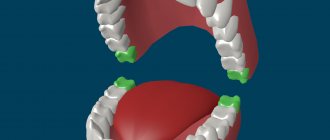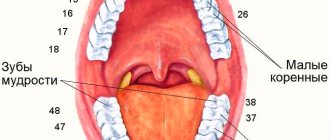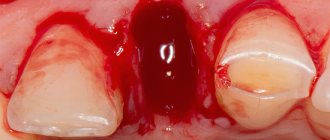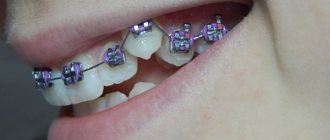Features of tooth extraction in the upper jaw
Unlike lower “eights,” upper wisdom teeth are considered less problematic. They tend to grow straighter, have less retention, and rarely have roots that are bent, twisted, or excessively long. The bone of the upper jaw is not so massive and dense, there are fewer blood vessels in the soft tissues, and the likelihood of hitting the trigeminal nerve is lower. Therefore, the upper wisdom teeth rarely have to be removed, and if it comes to surgery, it is easier than removing the lower wisdom tooth.
Simple removal of the top eight
Simple is the removal of the upper wisdom tooth, which does not require preliminary dissection of the gums. This is how molars are removed that have erupted without pathologies and have small, even roots. Simple removal is carried out in 4 stages.
- The doctor conducts a diagnosis
- takes an X-ray or CT scan, assessing the position of the tooth and the structure of the root system. - The patient receives pain relief.
Removal of the upper “eight” is usually performed under local anesthesia. - The doctor places forceps on the crown of the tooth and performs luxation and traction
- he rocks the tooth and pulls it out of the socket. - The hole is treated with an antiseptic and, if necessary, sutured.
Read more about the operation in a separate article.
Preparing for surgery
Before removing a wisdom tooth in the upper jaw, the doctor prepares the patient for the upcoming operation. The preparatory process consists of:
- X-ray examination of the problematic tooth;
- clinical examination of the patient for the presence of pathologies and other concomitant diseases that may affect the course of the operation;
- removal of subgingival and supragingival deposits from the tooth being removed and adjacent teeth to prevent the penetration of infected plaque into the alveolus.
The surgeon also assesses the patient’s psycho-emotional state and, if necessary, recommends taking a sedative.
Complex removal of a wisdom tooth in the upper jaw
A complex operation involves additional manipulations to extract a molar: cutting the gum, sawing the crown, extracting the tooth in parts. This is how impacted, semi-impacted and dystopic teeth are removed. The percentage of complex operations when removing the top eight is small, but sometimes they still have to be performed. Here's how it happens.
- As with a simple operation, an X-ray
or
CT
, otherwise there is a chance that the operation will be performed poorly. - The doctor numbs the gum.
In the most severe cases, removal of the upper wisdom tooth can be performed in a hospital setting under general anesthesia, but anesthetic injections are more often used. - An incision
is made , the mucous flap is peeled off, and access to the crown is opened. - The doctor begins to extract the molar
. Complex teeth often have to be removed piece by piece, carefully cutting them with a drill. Sometimes they even cut down a section of the jawbone to gain access to the roots. - After the tooth is removed, the doctor checks the socket for the presence of bone fragments, treats the wound and sutures the gum. If there has been a resection of the jawbone, then osteoplasty
- the hole is filled with bone chips, which over time will form new bone tissue to replace the removed one.
After a complex wisdom tooth extraction, the patient should prepare for a long rehabilitation: the wound can take up to several weeks to heal.
Use of anesthesia
Tooth extraction, like any other operation, is performed with the use of painkillers. Most often, local injection anesthesia is used: the doctor injects an anesthetic directly into the gum, and within 3-5 minutes it completely loses sensitivity. To properly numb the surgical site, two injections are required - into the outer and inner parts of the gums. The use of local anesthesia is possible on an outpatient basis; after the operation, the patient can go home.
But sometimes the “eights” have to be removed under general anesthesia. It is usually used if the case is complex and a long operation is required, or several teeth need to be removed, or if the patient is experiencing psychological difficulties. General anesthesia requires hospital conditions, and its price is much higher.
Temporary front teeth
After tooth extraction, it is impossible to immediately install artificial permanent ones - the wound needs to heal. In addition, the orthodontist takes time to make the prosthesis.
In the modern world, there is a way out of such an unpleasant situation - temporary front teeth. After removal, they can be installed almost immediately. This is a special prosthesis, shaped somewhat like a butterfly (it has attachments resembling insect wings). It is made of acrylic or plastic.
It is difficult for others to distinguish a “butterfly” from a lost tooth. The temporary prosthesis is attached to adjacent incisors and molars using its clasp wings. What is important is that they do not damage the enamel of neighboring teeth.
Patients and orthodontists highlight the following advantages of such a prosthesis:
- Suitable for both adults and teenagers.
- Affordable price.
- Quick fixation on adjacent teeth without harming them at all.
- The gums do not hurt after removing the front tooth and installing the “butterfly”. The patient does not feel discomfort and quickly gets used to the prosthesis.
- Both removing and fixing the temporary prosthesis is easy.
It is important to note another positive effect of the “butterfly” - it performs a protective function. The prosthesis protects the wound-socket at the site of the extracted tooth. Moreover, this is protection not only from pathogenic microorganisms, but also from the ingress of food when biting and chewing it.
Is it painful to remove an upper wisdom tooth?
Based on patient reviews, we can conclude that what scares them most about the operation of removing the upper “eights” is pain. But you shouldn’t be afraid of it: modern anesthetics completely block unpleasant sensations. Even if one of the drugs did not provide high-quality pain relief, the doctor will always be able to choose another one. There is no need to endure pain during wisdom teeth removal!
Most often, patients complain of pain not during, but after surgery. This is quite predictable: the anesthesia wears off and the body “remembers” the wound in the mouth. To relieve pain during the rehabilitation period, the doctor prescribes painkillers to the patient. With a simple removal of a wisdom tooth from above, 1-2 appointments may be enough, but after a complex operation, you will have to take pills for several days.
You may also be interested in:
Patient reviews. Works of doctors Video about the clinic
Sign up for a consultation
three ROOTT specialists + diagnostics as a gift
All specialists Our specialists
Shirokov Yuri Yurievich
orthopedic dentist, candidate of medical sciences
0:45
Omerelli Emir Romanovich
maxillofacial surgeon-implantologist and candidate of medical sciences
0:45
Possible complications
The structural features of wisdom teeth determine the possibility of surgical and postoperative complications - this is another reason for patients to be concerned about the removal of wisdom teeth. Fortunately, they are quite rare and in most cases are associated with insufficient professionalism of the doctor. If the surgeon acts carefully, then unpleasant consequences can be avoided. However, it is worth knowing what you might encounter.
- Tooth destruction during the extraction process.
This can happen if the integrity of the enamel is damaged by caries, and the doctor presses too hard on the forceps. It is accompanied by a characteristic cracking sound and can greatly frighten the patient. Requires careful removal of fragments from the hole. - Fracture of the jaw bone.
This is also a consequence of the rough work of the surgeon, who, by applying forceps, can capture part of the alveolar process along with the tooth. - Alveolitis.
This is inflammation of the socket, accompanied by swelling, pain, fever and bad breath. Requires immediate sanitation of the wound surface and antibiotics. - Damage to the maxillary sinus.
A rare but very dangerous complication when perforation of the wall of the maxillary sinus occurs. To avoid this, the doctor should carefully study the x-ray and act as carefully as possible.
Complications after removal
After tooth extraction, my front teeth hurt. This is one of the consequences of the operation. Tooth extraction is considered a serious procedure associated with injury to the soft tissues of the oral cavity and the formation of a hole.
Complications here are not necessary, but still not excluded. Most often, patients experience the following:
- Opening of bleeding. Normally, it stops on its own a few minutes after surgery. However, there is nothing to worry about if the wound continues to bleed throughout the day. But if the manifestation drags on for a longer period, you need to consult a doctor.
- Injuries from unprofessional actions of a doctor - damage to neighboring mucous membranes, breaking off the root and pushing it deep into the jaw, damage to neighboring teeth.
- Nerve damage (if depulpation is not performed).
- Alveolitis is an inflammation of the formed hole in the gum. It develops if a blood clot does not form there in time. That is why you should not eat, drink, or rinse your mouth for some time after surgery.
Recovery period
How long does recovery take after removal of upper wisdom teeth and what limitations does it impose? In most cases, after 1-2 days the patient returns to normal life, but sometimes recovery takes longer. To prevent the rehabilitation period from being prolonged, it is very important to follow the doctor’s recommendations:
- take prescribed antibiotics, painkillers and anti-inflammatory drugs;
- do not visit the bathhouse, sauna, swimming pool, or take a bath;
- follow a diet, if possible, eat only soft foods;
- refrain from smoking.
If the doctor did not make mistakes during removal, and the patient carefully followed all the doctor’s recommendations, then the recovery period will pass quickly, and the problem of the upper “eights” can be forgotten forever.
Operation stages
The operation procedure for removing the eighth tooth consists of several successive stages:
- diagnostics using visual and hardware methods. Using an x-ray image, the doctor determines the structure, location and length of the molar roots. If there is an inflammatory process, the doctor finds out its location;
- planning a surgical procedure;
- carrying out local anesthesia using the injection method;
- If the position and condition of the tooth allows the cheeks of the forceps to grasp it, then the doctor loosens it in the socket and then removes it from the alveoli. If this method cannot be used in a specific clinical situation, for example, when removing an impacted or dystopic tooth, then the surgeon dissects the gingival and bone tissues with a scalpel, then uses a drill to separate the coronal part and fused roots. Then, using surgical instruments (forceps, elevator, chisel, etc.), the wisdom tooth is removed in parts;
- treatment of the surgical wound and socket in the alveolar process with antiseptics;
- suturing the gums with special surgical threads and (or) packing the socket.
After some time, a clot forms in the hole, which prevents infection of the wound and speeds up its healing. If necessary, especially in the presence of an inflammatory process, the doctor prescribes a course of broad-spectrum antibiotics.









